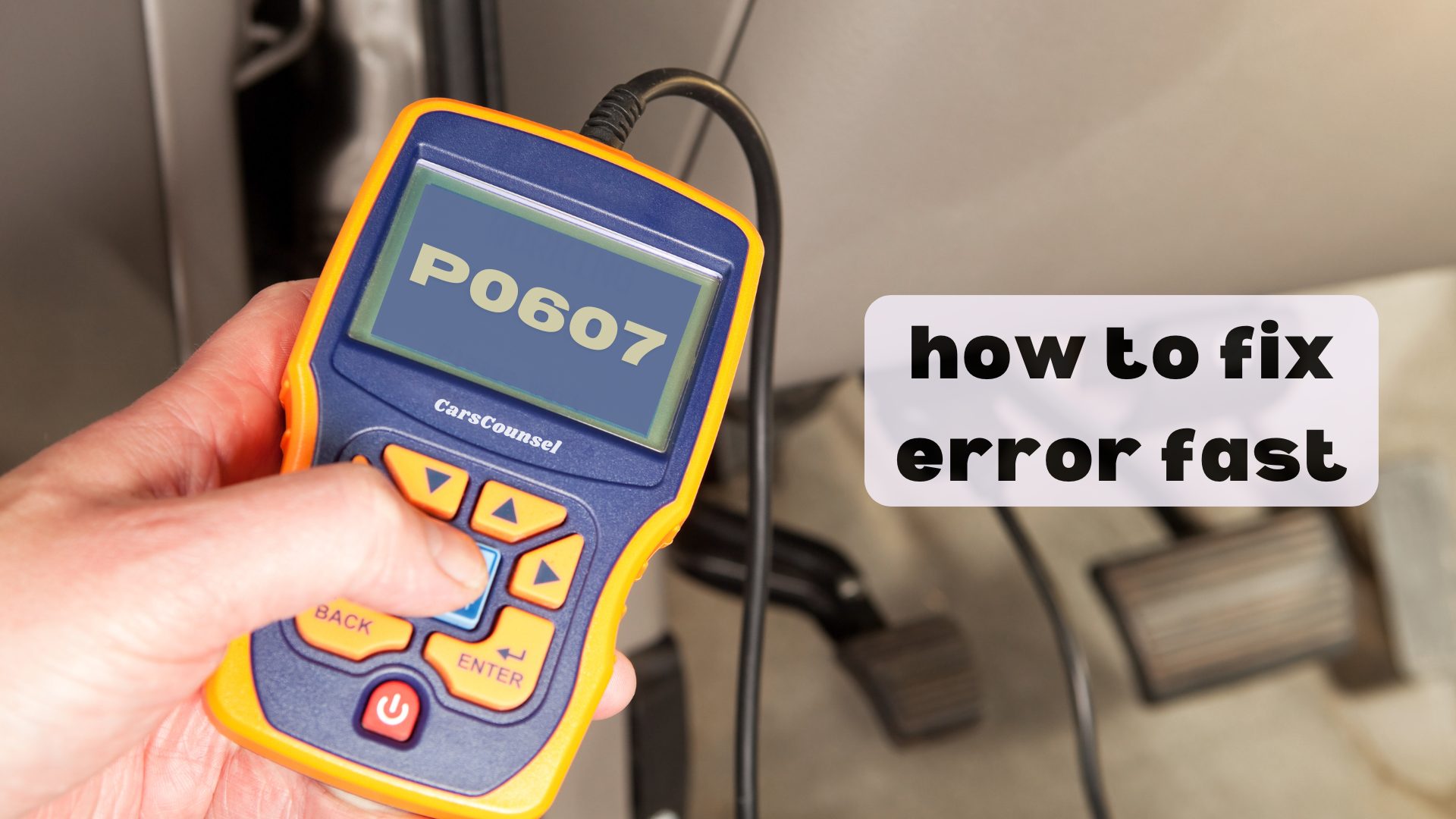Did you know that nearly 30% of vehicle owners encounter a P0607 code at some point? When this error pops up, it can leave you wondering how to fix it quickly and get back on the road.
You’ll need an OBD-II scanner to confirm the issue and check the battery voltage. Inspecting the wiring and connectors linked to the Engine Control Module (ECM) is essential.
But what if the problem persists even after these steps? Learn how to fix this OBD2 Codes error quickly and get your car running smoothly again.

Quick Navigation
Key Takeaways
- Use an OBD-II scanner to confirm the P0607 code and see if there are any other related codes.
- Check the battery’s voltage and condition to make sure it’s up to spec and stable.
- Look at the wiring and connectors connected to the ECM for any damage or corrosion.
- Update the ECM software to the latest version to fix any possible software issues.
Understanding the P0607 Code
When your vehicle’s check engine light comes on and you get a P0607 code, it means there’s a problem with the Engine Control Module (ECM) or Powertrain Control Module (PCM).
The ECM is essential for managing engine performance, such as fuel injection and ignition timing, which impacts fuel efficiency and how well your car runs.
To figure out what’s wrong, you’ll need diagnostic tools like an OBD-II scanner. This tool will help you confirm the P0607 code and check if the ECM is working correctly. It helps determine whether the issue is inside the ECM or if there’s a communication problem.
It’s important to diagnose the problem correctly before deciding if you need to reprogram or replace the ECM/PCM. Always check the vehicle’s service manual for detailed diagnostic steps.
Common Symptoms of P0607
If you see the P0607 code, you might experience poor fuel mileage, engine misfires, and the check engine light turning on. These signs can mean there are bigger problems with your car’s ECM. Many people think these issues are just minor glitches, but they often need a detailed look using diagnostic tools.
| Symptom | Description |
|---|---|
| Poor Fuel Economy | Using more fuel than usual |
| Engine Misfires | The engine runs unevenly |
| Check Engine Light | Warning light on the dashboard |
| Decreased Performance | Slow acceleration or stalling |
If you ignore these warnings, you could end up with serious engine damage. Use diagnostic tools to find out exactly what’s wrong so you can fix it properly and get back on the road fast.
Causes of the P0607 Code
Understanding the reasons behind the P0607 code is important for fixing the problem and getting your vehicle back to normal.
Electrical issues, like damaged wiring, can cause communication errors that set off this code. So, it’s crucial to check the wiring thoroughly to spot any damage or loose connections.
Battery problems, such as weak batteries or drains that sap power, can also affect the ECM (Engine Control Module). Sometimes, the ECM might need reprogramming to fix software glitches.
Issues with the alternator or starter motor can also lead to the P0607 code. A complete diagnostic check, covering all these areas, will help you find the exact cause and fix it quickly.
Make sure all software updates for the ECM are up-to-date to keep everything running smoothly.
Faulty ECM/PCM Issues
Diagnosing a faulty ECM/PCM means looking for problems with the hardware inside or the software that controls the engine.
Start by using diagnostic tools to check for error codes and see how well the ECM/PCM is working.
If you find hardware problems, you might need to replace the ECM. You can choose between original parts from the manufacturer or aftermarket options, depending on what fits and is reliable.
For software problems, updating the PCM software might fix things. Make sure you have the latest firmware to avoid issues from coming back.
After fixing the problem, clear the error codes and take the car for a test drive to make sure everything is working.
Regularly updating the software and keeping an eye on things can help keep your engine running smoothly.
Electrical and Battery Problems
After checking the engine control module (ECM) or powertrain control module (PCM) for any hardware or software issues, it’s crucial to inspect the electrical system and battery. These can cause the P0607 error code.
Start by thoroughly examining the electrical system for any damaged wires or bad connections. Also, check the battery’s condition because weak or unstable voltages can mess with the ECM. Regular battery maintenance, like cleaning the terminals and ensuring it’s fully charged, is key.
Look at the alternator and starter motor to make sure they aren’t causing voltage problems. Use a multimeter to measure the battery voltage and ensure it meets the manufacturer’s guidelines.
Fixing these electrical and battery issues can help prevent the P0607 code from coming back and keep your engine running smoothly.
Affected Car Models
When dealing with the P0607 code, it’s important to know that certain car models like the Chevy Cruze, Ford Focus, and Toyota Camry are more likely to have ECM-related problems.
In the Chevy Cruze, these issues can lead to lower fuel efficiency and noticeable power loss.
The Ford Focus might experience transmission slips or jerks, making driving unsafe.
The Toyota Camry can encounter engine stalling or misfiring when the ECM isn’t working right.
Knowing these common problems helps you take preventative steps and fix issues quickly.
Understanding these model-specific ECM problems will help you diagnose and repair the P0607 code more effectively.
Diagnosing the P0607 Code
To diagnose the P0607 code, start by using an OBD-II scanner to pull up the specific trouble codes and check the battery voltage to ensure it’s within the recommended range.
Begin with the ECM (Engine Control Module) diagnostics, focusing on understanding the retrieved codes accurately. Make sure the battery voltage matches the manufacturer’s specifications, as low or fluctuating voltage can impact the ECM’s performance.
Check all wiring and connectors linked to the ECM for any signs of wear, corrosion, or damage. Test the ECM for power loss or memory issues using specialized diagnostic tools.
After clearing the codes, take the vehicle for a test drive and monitor to see if the P0607 code comes back. This step-by-step approach ensures accurate and effective code interpretation.
Troubleshooting Steps
Start by making sure you have a good OBD-II scanner and check the car’s battery to ensure it has the right voltage.
Use the scanner to look for error codes in your car’s system.
Check the wires and connectors linked to the ECM to see if any are damaged or loose.
Use diagnostic tools to check if the ECM/PCM is losing power or has memory problems.
Clear all error codes and take the car for a test drive to see if the P0607 code comes back.
Refer to your car’s service manual for specific steps tailored to your model.
Proper troubleshooting is key to fixing the issue and avoiding further problems.
Fixing the P0607 Code
If tests show that the ECM (Engine Control Module) is faulty, you might need to replace it, but sometimes fixing damaged wiring or updating the ECM software can solve the problem.
First, look into ECM replacement options that work with your vehicle. Before deciding to replace the ECM, check all the wiring for any damage or rust since this could be causing the error code.
Also, make sure the ECM software is up-to-date because old or corrupted software can cause problems. You can use an OBD-II scanner to install the latest updates, which might fix the issue without needing new hardware.
Always check the battery and electrical system since these are important for the ECM to work properly. Following these steps will help you fix the problem accurately and effectively.
Preventive Measures for P0607
Preventive Measures for P0607
Regular maintenance and careful monitoring of your car’s electrical systems can help you avoid the P0607 code. Here’s what you need to do to keep your vehicle in top shape:
- Check the Battery: Test your battery voltage regularly to avoid power problems.
- Update Software: Make sure your car’s computer software is always up-to-date.
- Inspect Wiring: Regularly look at all wiring and connectors for any wear or damage.
- Watch Performance: Keep an eye on how your car is running to catch any early signs of computer issues.
More OBD-II Codes
Frequently Asked Questions
Can a Temporary ECM Reset Fix the P0607 Code?
You can reset the ECM using diagnostic tools, which might temporarily fix the P0607 code. However, it’s important to find and fix the root cause to stop the code from coming back and ensure your vehicle stays reliable in the long run.
Are Aftermarket ECMS Reliable for Resolving the P0607 Code?
When thinking about aftermarket ECMs, make sure they are reliable and fit your vehicle. They can boost ECM performance, but ensure the product meets original manufacturer standards to avoid future problems. Do your homework before deciding.
How Much Does It Typically Cost to Replace an Ecm?
Replacing an ECM usually costs between $500 and $1500, depending on your car. Repairing an ECM is usually cheaper, but don’t forget to include labor costs for an accurate estimate.
Can a P0607 Code Affect Emissions Testing Results?
Yes, the P0607 code can affect your emissions test. If your car has this code, it might fail the test because a bad ECM can mess up the engine, make more emissions, and turn on the check engine light, which inspectors will notice.
Is Professional Repair Necessary for Clearing a P0607 Code?
You should think about getting professional help to fix a P0607 code. Checking the ECM needs special tools to find the problem correctly. Fixes might involve reprogramming or replacing the ECM to make sure your vehicle runs well and stays reliable.
Conclusion
Got a P0607 error code? Here’s what to do next.
First, use an OBD-II scanner to confirm the error and check your battery voltage.
Look over the wiring and connectors for any damage and replace them if needed.
Make sure to update the ECM software too.
After making these fixes, clear the error codes and take your car for a test drive.
Isn’t it great to handle car problems quickly and easily?

